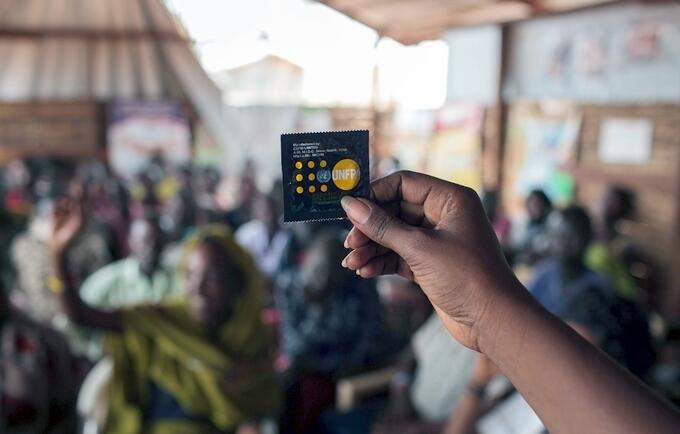As development partners, governments, donors, experts and other agencies gather in Kigali, Rwanda from 12-15 November for the 5th International Conference on Family Planning, Dr. Julitta Onabanjo, UNFPA Regional Director for East and Southern Africa, argues for condom manufacturing in Africa as a pivotal strategy for achieving the FP2020 vision.
The East and Southern African (ESA) region, home to nearly 550 million people, has made noteworthy progress in tackling HIV, sexually transmitted infections (STIs) and unmet need for family planning.
Today, the region has 30 per cent fewer new HIV infections when compared to 2010. And one in three women is now using contraceptives, compared to one in four in 2010.
Condoms – the only tool that provides triple protection against HIV, STIs and unintended pregnancies – have played a central role in this progress.
Yet despite the progress, ESA continues to be the region most affected by the HIV epidemic. It accounts for nearly half of the global HIV burden, but has only 6 per cent of the global population share. STI prevalence continues to be above global average, resulting in increased risk for HIV infections. And one in four women has an unmet need for family planning.
Adolescent girls and young women disproportionately bear the brunt of major public health threats. They account for 25 per cent of new HIV infections in the region, while their population share is around 17 per cent. The adolescent birth rate in ESA is 112 births per 1,000 girls aged 15 to 19 years, which is double the global rate.
This is why the condom continues to be central to all strategies for preventing HIV, STIs and unintended pregnancies.
A significant gap exists between the ‘regular supply’ of condoms and people’s ‘requirements’ in Africa, in particular in sub-Saharan Africa and the ESA region. Sub-Saharan Africa has an annual gap of more than 3 billion condoms, against a total need of 6 billion. This gap is staggering and it will continue to hinder progress for many countries, including most ESA countries, towards the 2030 Sustainable Development Goals relating to health.
These goals aim to end the epidemic of AIDS; ensure universal access to sexual and reproductive health care, family planning and education; and reduce maternal deaths by 70 per cent by 2030. The gap in condom ‘supply’ and ‘requirement’ to tackle HIV, STIs and unintended pregnancies is likely to worsen in the ESA region, as the population is expected to double by 2060 and external funding is not expected to increase substantially.
Currently, condom manufacturing occurs in five places in Africa. Together, these five manufacturers produce less than 10 per cent of the condom requirement for the entire continent. Moreover, none of these manufacturing units meet the pre-qualification standards set by the World Health Organization (WHO) and the United Nations Population fund (UNFPA). This limits their ability to participate in global procurement drives. UNFPA is supporting these units, as well as other potential investors and manufacturing units, to improve their manufacturing practices for meeting the pre-qualification standards.
It is gratifying to acknowledge that African Heads of State and Governments at the African Union (AU) Summit in 2007 endorsed the Pharmaceutical Manufacturing Plan for Africa (PMPA) to promote the industrial development and production of quality medicines, including condoms.
The Southern African Development Community (SADC) is also committed to supporting the initiative. A feasibility study undertaken by the SADC Secretariat in 2016 noted that the total SADC male condom market was 4 billion units worth USD 105 million, almost all of which are imported from outside the region. Only 10 percent were produced by factories from Botswana, Namibia and South Africa. It is thus imperative to tap into the huge market in the SADC region.
Africa, and in particular the ESA region, needs a sense of urgency to identify, plan and develop condom manufacturing plants as viable operations. Local production of condoms in the region most affected by the HIV epidemic has a number of distinct advantages.
Firstly, it helps to meet the need for the billions of condoms required to prevent transmission of HIV, STIs and unintended pregnancies. Secondly, increased availability of condoms manufactured on the continent will help ensure a speedy supply due to geographic proximity, especially in response to emergency supplies for avoiding stock-outs, and it will encourage improved local procurement and supply chain management. Thirdly, this will create employment opportunities, skills development, sustainable transfer of know-how and technology, promote trade within the continent, save much-needed hard currency for the continent, and involve the private sector in assisting governments to tackle HIV, STIs and unintended pregnancies. More importantly, this will help meet several targets of the 2030 Global Goals.
Comprehensive condom programming is at the heart of our work at UNFPA. A recent study by the organization shows that effective condom programming in high burden countries could avert up to 17 million HIV infections, 700 million STIs, and 420 million unintended pregnancies by 2030.
However, limited production of quality condoms in Africa continues to be a key barrier to regular supply and use of condoms in the ESA region. Therefore, UNFPA is working with investors, manufacturers, governments and development partners to enhance Africa’s condom manufacturing, procurement and distribution capacities.
Condom manufacturing has become a critical health and economic imperative for Africa which should no longer be delayed. And the strategic engagement of all stakeholders, including investors, manufactures, governments and development partners is one of the keys to making it happen.
Dr. Julitta Onabanjo
Regional Director
UNFPA East and Southern Africa


